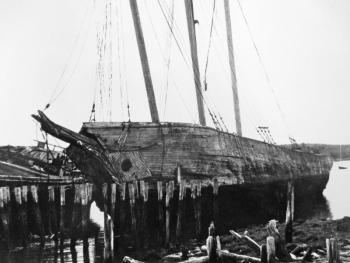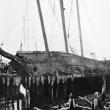Story retold of Wiscasset’s Hesper and Luther Little
 The Luther Little shown shortly after its rigging gave way and rear mast broke on the morning of July 29, 1979. On the right are the remains of the Hesper. The old ships were beached on the Wiscasset waterfront north of the pier around 1940. PHIL DI VECE/Wiscasset Newspaper
The Luther Little shown shortly after its rigging gave way and rear mast broke on the morning of July 29, 1979. On the right are the remains of the Hesper. The old ships were beached on the Wiscasset waterfront north of the pier around 1940. PHIL DI VECE/Wiscasset Newspaper
 The Luther Little shown shortly after its rigging gave way and rear mast broke on the morning of July 29, 1979. On the right are the remains of the Hesper. The old ships were beached on the Wiscasset waterfront north of the pier around 1940. PHIL DI VECE/Wiscasset Newspaper
The Luther Little shown shortly after its rigging gave way and rear mast broke on the morning of July 29, 1979. On the right are the remains of the Hesper. The old ships were beached on the Wiscasset waterfront north of the pier around 1940. PHIL DI VECE/Wiscasset Newspaper
The Hesper and Luther Little, “last of the four-masted schooners,” are in the news again. After pieces from them were found recently at the old landfill people are once again talking about the old ships.
Everyone seems to have a different opinion for what to do next. Some want the relics put on display, others suggest auctioning them off. Then there are those who say the odds and ends should be left right where they are. If all this wasn’t enough, a man has laid claim to a length of timber from the Hesper’s prow he said he found floating in the Sheepscot River 37 years ago. Why after so long all the renewed interest?
“For years when people thought of Wiscasset, they naturally thought of the Hesper and Luther Little,” Ben Rines Jr. chairman of Wiscasset’s board of selectmen said. “They were really a part of the town’s identity.”
Rines said for more than 50 years people wouldn’t think of visiting Wiscasset without heading to the waterfront to have a look at the old ships. Thousands of photographs were taken of them from every conceivable angle. Hundreds of portraits were painted. Many of the braver souls ventured on-board, climbed the masts, and explored below decks. Rines recalled going on the Luther Little when he was in high school in the summer of 1970. Eight years later he and hundreds of others watched as the Hesper burned during the town’s Fourth of July celebration.
“I’ll never forget the night the ships caught on fire,” Rines continued. “They were burning the same time the fireworks were going off. Boothbay Harbor sent their fireboat and fought the fire from the water while the Wiscasset Fire Department poured water on it from the shore. When they finally got the fire out people watching cheered.”
The Hesper and Luther Little take to the sea
Both schooners were built as merchant ships during the last years of World War I. The Luther Little was launched at Somerset, Massachusetts in 1917 and the Hesper at South Somerset a year later. Although they were sailing ships, each was equipped with small, coal-fired boilers used to power steam winches for the capstan and hoisting the anchor. On the Luther, the boiler also provided steam heat and hot water to the ship’s forward and main cabins.
One story often told about the Luther Little took place in June 1918. While at sea under the command of Capt. W.P. Richardson the crew rescued two balloonists who had crashed in the Atlantic Ocean off the coast of Delaware. The ship’s crew also managed to save the aerial balloon the men were piloting that had embarked from Cape May, New Jersey.
The Luther and Hesper were used primarily to haul coal and lumber. Times however were changing, by the mid-1920s sailing ships could no longer compete against steam-driven vessels and one by one were taken out of service.
The ships arrive at Wiscasset
As far as Wiscasset is concerned, the story of the old ships began in 1932 when Frank W. Winter of Auburn bought both at auction and had them towed here. Winter planned to use them in conjunction with his narrow gauge rail line, the Wiscasset, Waterville & Farmington Railroad. His plan was to carry timber cut in northern Maine by rail to Wiscasset and then rely on the ships to transport the product to Boston and New York markets. The venture never got out of the planning stages and failed partly due to the Depression-era economy. After arriving at Wiscasset, the Hesper and Luther Little never took to the open sea again.
In the spring of 1940 the ships were floated ashore during a flood tide and winched closer to the place that became their final resting place. Years later, the late Chris Roy of Westport wrote a detailed history of the old ships. He titled it “The Wiscasset Ships A Remembrance” which he both published and printed in 1994. According to Roy when the ships were being grounded there wasn’t enough water. To lighten them the anchors were removed, loaded onto a barge, and then pitched overboard into the river.
“Today as the Luther Little and Hesper sail on into memory, it is somehow comforting to believe that just north … beneath the mud of the Sheepscot River, lie the seven ton anchors, safe from tide and time,” wrote Roy, although he doesn’t say where he got this information. Others say the anchors were sold for scrap during the second world war.
According to Roy, soon after the ships were grounded, a Portland man bought the Hesper’s windless and donkey steam engine. The same salvager cut down and carried away the Hesper’s four masts giving the ship the appearance of an abandoned derelict.
After Winter died, his properties, including what remained of the old ships, were purchased by WIDCO (Wiscasset Industrial Development Committee). WIDCO formed in the early 1950s, and was a non-profit group made up of area businessmen. It launched an effort to clean up the Wiscasset waterfront, including removing several acres of rotting wharves. WIDCO didn’t concern itself with the old ships until 1965 when there was talk of restoring the Luther Little as a tourist attraction. An article from the Portland Press Herald found in the Wiscasset Public Library archives tells of WIDCO’s plans to burn the Hesper to her waterline and concentrate efforts on saving and preserving the Luther Little.
Although there was a great deal of talk at the time, ultimately nothing happened. The ships were left as they were and continued to sink deeper in the mudflat with each passing year.
Talk of preserving the ships began again in 1978 after the Hesper caught fire during the town’s Fourth of July’s fireworks display. The reported cause was a sparkler tossed on board. The blaze sent huge flames leaping into the night sky and totally consumed the ship’s forward cabin. By this time WIDCO wanted nothing more to do with the old ships, one board member referring to the aging hulks as an eyesore. WIDCO eventually offered the town all of its remaining waterfront assets including what was left of the old ships.
Around the same time it was determined the Hesper and Luther Little were in fact the last of the original four-masted schooners left in the country. Following the fire, Peter Throckmorton, a marine archaeologist and curator-at-large of the National Marine Historical Society, surveyed and accessed the two ships. Throckmorton, quoted in the Wiscasset Newspaper, believed they could still be saved but warned time was running out. If nothing was done he said they’d gradually break apart and collapse under their own weight. Town officials hoped they might get federal funding or other grant monies to pay for stabilizing the ships. It didn’t happen and once again the ships were left as they were.
Enter Friends of the Wiscasset Schooners
The next group to take an interest in the old schooners was the Friends of the Wiscasset Schooners formed in the latter part of 1978. The group made up of volunteers including Chris Roy hoped to get enough private donations to stabilize the old ships. As fate would have it, the following summer an earth tremor of all things caused the Luther’s rear mast that had been leaning stern-wise to come crashing down. Next to go was the schooner’s stern section; it gave way and sank into the mudflat. By 1981, the Friends had given up as well, agreeing nothing more could be done to save the old ships. Once again they were left to the mercy of Mother Nature.
The old ships were back in the headlines again after what was left of the Hesper’s hull collapsed following a severe storm in November of 1990. The talk this time was whether to leave what was left of the ships where they were, or have them razed. The following spring the Luther Little’s bow broke away. During the Fourth of July celebration the Luther then caught fire after someone fired a flare gun at it. This time, Roy wrote, the crowd watching the spectacle was about equally divided. Some shouted encouragements to firemen to save the old ships, others shouting, “Let ‘em burn!”
Ships demolished but pieces were saved
By the spring of 1998, the powers that be decided it was time for what was left of the ships to go and they were demolished. The remains were hauled to the landfill and piled into a small mountain that stretched the length of a football field. For posterity’s sake, a picture was taken of the mound and placed on the back cover of that year’s town report. For a time people were allowed to take whatever pieces they wanted from the pile and many did. One man took enough lumber to have a set of kitchen cabinets made. What remained of the pile was then run through a chipper and the remains carted away for good.
The pieces the town had saved during the ships’ demolition were inventoried and stacked at the former landfill for safekeeping. Some were offered to and taken by the Maine Maritime Museum in Bath. There was talk of putting what remained of the schooners on display at the Wiscasset waterfront, perhaps in a small building where photographs and other schooner memorabilia could be preserved. No monies were raised and the project was abandoned.
Until this past summer, the few remaining pieces of Hesper and Luther Little, including the bollards, turnbuckles and sections of the masts, were forgotten behind a locked fence. Now that they’ve been rediscovered after 17 years, the old ships are one again being talked about.
Event Date
Address
United States






















